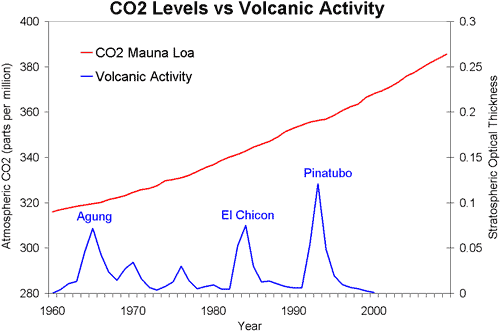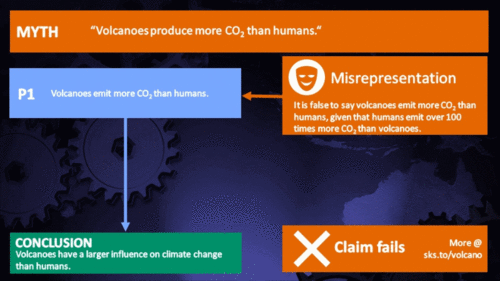Do volcanoes emit more CO2 than humans?
What the science says...
| Select a level... |
 Basic
Basic
|
 Intermediate
Intermediate
| |||
|
Volcanoes emit around 0.3 billion tonnes of CO2 per year. This is about 1% of human CO2 emissions which is around 29 billion tonnes per year. |
|||||
Volcanoes emit more CO2 than humans
"Human additions of CO2 to the atmosphere must be taken into perspective.
Over the past 250 years, humans have added just one part of CO2 in 10,000 to the atmosphere. One volcanic cough can do this in a day." (Ian Plimer)
Volcanoes emit CO2 both on land and underwater. Underwater volcanoes emit between 66 to 97 million tonnes of CO2 per year. However, this is balanced by the carbon sink provided by newly formed ocean floor lava. Consequently, underwater volcanoes have little effect on atmospheric CO2 levels. The greater contribution comes from subaerial volcanoes (subaerial means "under the air", referring to land volcanoes). Subaerial volcanoes are estimated to emit 242 million tonnes of CO2 per year (Mörner and Etiope (2002)).
In contrast, humans are currently emitting around 29 billion tonnes of CO2 per year (EIA). Human CO2 emissions are over 100 times greater than volcanic CO2 emissions. This is apparent when comparing atmospheric CO2 levels to volcanic activity since 1960. Even strong volcanic eruptions such as Pinatubo, El Chicon and Agung had little discernable impact on CO2 levels. In fact, the rate of change of CO2 levels actually drops slightly after a volcanic eruption, possibly due to the cooling effect of aerosols.

Figure 1: Atmospheric CO2 levels measured at Mauna Loa, Hawaii (NOAA) and Stratospheric Aerosol Optical Thickness at 50nm (NASA GISS).
The Mount Pinatubo eruption emitted 42 million tonnes of CO2 (Gerlach et al 1996). Compare this to human emissions in 1991: 23 billion tonnes of CO2 (CDIAC). The strongest eruption over the last half-century amounted to 0.2% of human CO2 emissions in that year.
Intermediate rebuttal written by John Cook
Last updated on 6 July 2015 by . View Archives































 Arguments
Arguments





































Climate Myth...